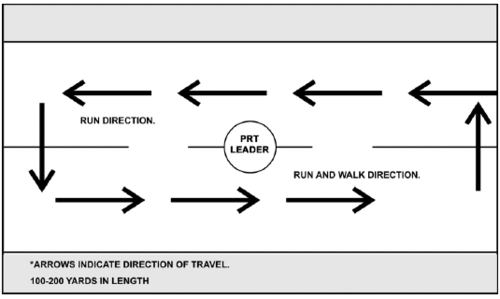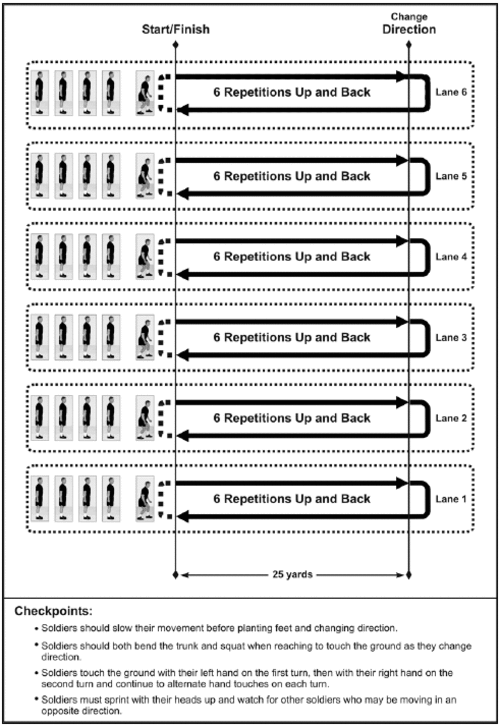Speed running is a popular exercise that involves high-intensity running. As the name suggests, it refers to running at a high (maximum speed) speed.
- Some people confuse running with jogging, but it is crucial to understand that both are different forms of exercise.
- In jogging, you run slowly for an extended period, whereas in speed running, you run at high intensity with maximum speed for short intervals.
- Speed running requires high energy and intrinsic motivation. It doesn’t require any special equipment or props.
- You can do it independently, but it is good to get guidelines from some professionals to understand how to balance your body while running wildly.
Table of Contents
show
Army PRT Speed Running Exercise
Speed running is based on the training principle that more intense work can be performed if the work is interspersed with periods of recovery.
- Improvements in physical fitness are affected to a greater extent by the intensity of training than by the frequency or duration of the training.
During speed running, Soldiers perform a work interval in a specified time for a specific number of repetitions.
- The work intervals are followed immediately by an active recovery interval. Multiple work intervals cause the onset of fatigue many times during a single training session.
Benefits of Speed Running:
- Resistance to Fatigue: Regular speed running amplifies muscle endurance by exposing them to repeated high-intensity efforts.
- Enhanced Performance: This regimen bolsters both anaerobic and aerobic endurance, enabling Soldiers to maintain high-intensity performance for extended periods.
Balancing Work and Recovery intervals
- The synergy of work and recovery intervals is the crux of the training stimulus in speed running.
- Short Recovery: Insufficient recovery time might impede the body’s ability to gear up for the subsequent high-intensity interval, compromising the training effect.
- Extended Recovery: Conversely, an overly long recovery period can reduce the training intensity, diminishing some benefits.
- Optimal Recovery: The ideal recovery duration depends on the intensity and length of the preceding work interval. It’s essential to strike the right balance to maximize the benefits of speed running.
- Work-to-Recovery Ratio: An appropriate work-to-recovery ratio for improving soldiers’ physical readiness is 1:2. For every unit of intense activity, there are two recovery units.
Critical Variables in Speed Running:
- Work Duration: The length of the high-intensity interval.
- Recovery Duration: The period for active recovery following the work interval.
- Number of Repetitions: The count of cycles of work and recovery periods within a training session.
Prescribed Speed Running Activities:
- The speed running activities appropriate for Soldiers to improve physical readiness and ACFT 2-mile run performance is 30:60s and 60:120s.
- 30:60s: 30 seconds of sprinting followed by 60 seconds of recovery.
- 60:120s: 60 seconds of sprinting followed by 120 seconds of recovery.
- Detailed prescriptions for these activities in different training phases are provided in Table 10-2.
Role of Assistance Instructors (AIs):
- AIs actively participate in speed running alongside the Soldiers, providing a dual role of motivation and monitoring.
- Their presence ensures consistent performance and adherence to the prescribed intensity.
The PRT Leader’s Role:
- The PRT leader positions himself to supervise the conduct of speed running and uses a stopwatch and a whistle to signal the “Start” and “Stop” of each work and rest interval.
- These cues are crucial for maintaining the integrity of the workout and ensuring the prescribed intensity and duration are met.
30:60s Speed Running: An Overview
- The 30:60s training aims to enhance Soldiers’ anaerobic endurance by interspersing short sprints with recovery walks, adhering to a work-to-recovery ratio of 1:2.
- Soldiers will perform 30:60s, adhering to a work-to-recovery ratio of 1:2.
- During the work interval, Soldiers will sprint for 30 seconds. During the recovery interval, Soldiers walk for 60 seconds.
30:60s Format:
- Work Interval: Soldiers sprint vigorously for 30 seconds.
- Recovery Interval: Soldiers transition to a walk for 60 seconds, allowing their bodies to recover before the next sprint.
- This combination of sprinting and walking constitutes one complete repetition of a 30:60.
- Due to the intensity of the sprints, Soldiers might disperse across the running track. If this happens, the PRT Leader can opt to regroup the Soldiers before initiating the next work interval.
- Before diving into the 30:60s, it’s recommended for Soldiers of all ability levels to jog slowly for ¼ mile, serving as a warm-up.
- Post-exercise: Soldiers should walk cool-down for at least 3 minutes before transitioning to other physical activities or entering the recovery phase.
Training Progression:
- The specifics of the speed running progression for the 30:60s can be found in Table 10-2.
- Following this progression helps Soldiers systematically enhance their endurance without risking injury.
60:120s Speed Running: An Overview
- The 60:120s training involves Soldiers sprinting for 60 seconds (work interval) and then walking for 120 seconds (recovery interval) for effective endurance training.
60:120s Format:
- Work Interval: Soldiers sprint for 60 seconds.
- Recovery Interval: Soldiers walk for 120 seconds.
- This combination constitutes one repetition of a 60:120.
- Soldiers tend to scatter over the running track due to the high-intensity sprinting. If necessary, the PRT leader will regroup the Soldiers before initiating the next work interval.
- As a warm-up, all ability groups should engage in a slow-paced jog for a distance of ¼ mile before starting the 60:120s.
- Following the exercise, Soldiers must walk for at least 3 minutes to cool down before transitioning to other activities or complete recovery.
Recommended Training Areas:
- The ideal training environment for 30:60s and 60:120s is a standard ¼-mile or 400-meter oval running track.
- The PRT leader should be positioned centrally, allowing them to supervise all Soldiers effectively. This central positioning also ensures that Soldiers can hear the leader’s whistle signals indicating when to start or stop the intervals.
- If the Speed running exercises are executed on a straight road, several precautions are necessary:
- The road should be spacious enough to prevent collisions when Soldiers turn around.
- The suggested length for holding 30:60s or 60:120s on a straight path ranges from a minimum of 100 yards to a maximum of 200 yards, as visualized in Figure 10-10.

300-Yard Shuttle Run: An Overview
- The 300-yard shuttle run develops the ability to sprint repeatedly after changing direction.
- It indicates the Soldier’s anaerobic endurance, speed, and agility.
- The 300-yard SR is conducted from the extended rectangular formation (covered), as shown in the image below.
Setup and Formation:
- On the command “Ready,” a Soldier from each column moves behind the starting line, assuming a staggered stance.
Execution:
- On the “GO” command, Soldiers sprint towards a line 25 yards away from the start.
- Upon reaching the 25-yard line, they touch it (or beyond) using their left hand.
- They then dash back to the starting/finish line, touching it with their right hand. This completes one repetition.
- The process is repeated six times, alternating the hands used to touch the lines.
- On the final, sixth repetition, Soldiers sprint past the start/finish line without any touch.
- Throughout the exercise, it’s vital to maintain lane discipline and keep your head up to avoid potential collisions.
- The image below visually represents the run’s pattern and requirements.
Guidance and Monitoring:
- PRT leaders and Assistant Instructors (AIs) ensure that Soldiers adhere to their lanes and stay alert for fellow Soldiers moving in the opposite direction.

Muscles Worked by Speed Running Exercise
Speed running is a complete body exercise involving all body muscles. It mainly targets:
- Glute muscles
- Hamstrings (the back portion of the thigh)
- Calf Muscles (the rear portion of the lower leg)
- Quadriceps
- Abdomen muscles
- Hip flexors
- Upper body muscles
Summary Benefits of Speed Running
The following are the benefits of speed running workouts:
- It enhances bone density
- Excessive speed running decreases the probability of heart disease
- It strengthens lower body muscles
- It helps to burn calories and causes weight loss
- Improves mental health by releasing endorphins
- It offers time efficiency and good exercise for busy people
Drawbacks
Along with the pros, here are the cons you must be cautious about before speed running.
- Running at a fast speed can cause you to lose your balance. You can trip off or even fall if you lose your balance while running, leading to minor to severe injuries.
- It can put pressure on joints of the lower body and lead to joint pain and even injury.
Army References
- Refer to Table 10-2 for endurance and mobility activities, intensity, duration, and volume prescriptions within the toughening and sustaining phases.
- In addition, Chapter 5, Planning Considerations, provides the template for commanders and PRT leaders to implement endurance and mobility activities into their PRT programs.
Latest posts by George N. (see all)
- Empowering Transactions: Navigating Firearms Sales with Proper Documentation - April 8, 2024
- Army PRT – Preparation and Recovery 2024 - March 18, 2024
- Active and Reserve Components 2024 - March 6, 2024
